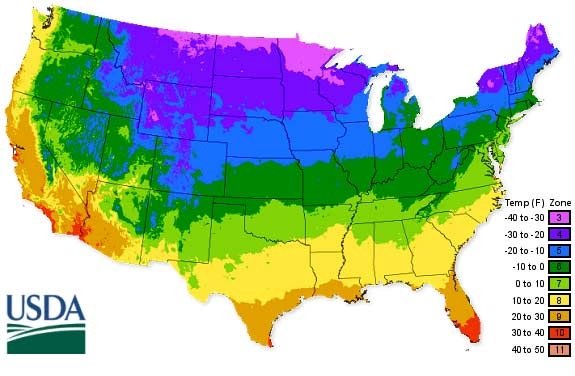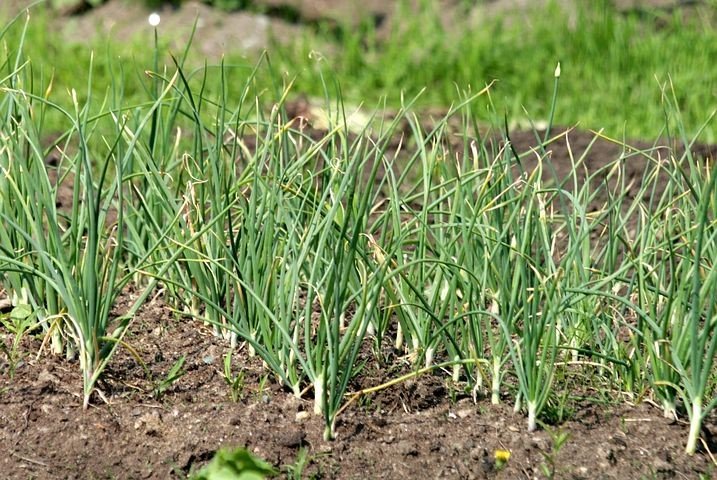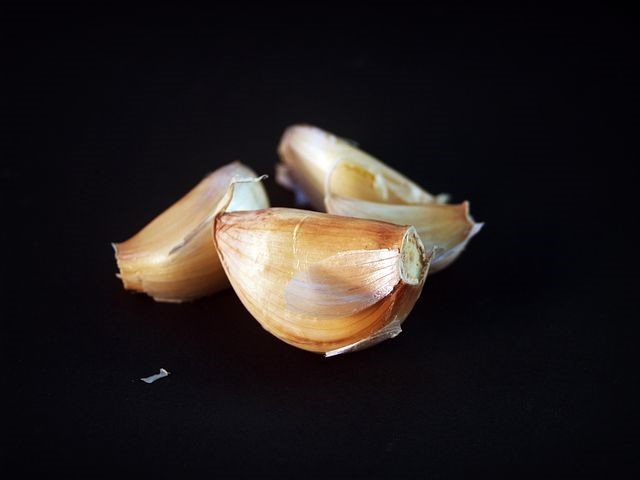Garlic is a popular vegetable among many cuisines for its flavor and benefits. While Garlic can be planted in the spring, it is best to plant them in the fall as it would yield bigger bulbs and a better harvest.
When to plant garlic? Garlic is a root vegetable that should be planted in the fall (autumn). During the winter, garlic remains under the soil developing its bulbs. The plants shoot above ground as the spring arrives.
Best Season to plant garlic
Hardneck garlic needs 4 – 6 weeks of cold temperature below 40-45 F to develop bulbs. Thus you need to plant the garlic cloves 4 – 6 weeks before the ground above freezes, giving enough time for bulbs to grow under the ground. This process is called Vernalization.
For different zones in America based on temperature, the ideal month for growing garlic varies.
Here is an easy map that shows the climate zones of the USA. If you want to be specific, check this link with your zip code- https://planthardiness.ars.usda.gov/PHZMWeb/InteractiveMap.aspx

Garlic Planting Season Chart
| Climate Zone | Planting Date |
| 0-3 | Late August/Early September to Late September |
| 3-5 | Mid/Late September to Early/Mid October |
| 5-7 | Early/Mid October to Late October |
| 7-9 | Late October to November |
| 9-10 | Late October to December |
The fall to mid-fall is the nationally accepted planting time for garlic. The time between this and the next season is used to establish roots. During winter the ground will freeze and no growth above the soil will take place.
Fall planting of Garlic
The best time to grow garlic is mid-fall (mid-autumn). You can easily identify fall or autumn as a time when trees and plants start to lose their leaves.
Depending on your area in the USA, fall has different dates. Generally, late September to November is the best time to plant your garlic cloves.
As you sow, the roots will start to develop. Thus you need to ensure that you plant the cloves 4 – 6 weeks earlier than winter when the ground gets frozen. Till this time, the bulb would develop.
As the winter comes, the garlic would become dormant until when the summer arrives and the scrapes would shoot above ground. Most of the bulb development would keep happening in the summer.
Here are tips for growing garlic in the fall:
- Choose the large healthy cloves of garlic for planting. Use the smaller ones for eating. The bigger the clove size is, the greater the likelihood it will grow a nice, big head of garlic.
- Plant the Garlic cloves approx 3 – 4 inches apart
- Place the garlic clove upright (pointed end up and wide part downwards)
- Each row should be at least 10 to 14 inches apart
- The area for growing should be sunny and airy
- The soil should be well-drained, fertile, and have a pH between 6 to 7.
- Plant them in a raised or mounted bed if the ground near you freezes
- Garlic prefers cool temperatures for growth (0-10℃). This temperature is essential initially to help root development.
- Placing a layer of mulch over the garlic after 2 – 3 weeks of sowing can give protection from extreme frost.
During summer, the garlic bulb will mature below ground and can be harvested in summer.
How to Grow Garlic Indoors? Growing Garlic Bulbs and Scapes in Pots
Spring Garlic planting
Most of the garlic types grown in spring might suffer limited bulb formation. The garlic head will be small or lack well-developed garlic cloves.
Though if you have missed planting Garlic during fall, you may still plant in summer. You may not get large cloves, but you can still enjoy the mild flavor of green garlic.
Garlic lacks true seeds and therefore garlic cloves act as the only means of propagation. Cloves are the individual segments that constitute the garlic head. Each clove will grow into a new garlic plant when planted separately.
Why Garlic Turns Green or Blue? Is It Safe or Risky to eat? (Solved & Explained)
Different types of garlic based on climate
Generally, there are two main varieties of garlic that you can grow: Hardneck garlic and Softneck garlic.
Hardneck garlic
The hard neck variety of garlic is hardy and tolerates the harshest winters. People who stay in colder areas of America can plant this variant. Scrapes (flower stems) are an edible part of the garlic plant and are often removed to allow bulbs to reach larger sizes.
The name hardneck is due to a hard central stem around which the cloves grow. One drawback of the hardneck is they do not keep well and will not last as long as softneck garlic. Also, people say they are not as flavorsome as the softneck variant.
Hardneck garlic variants are:
- Korean Red
- Spanish Roja
- Siberian garlic
- Chesnok Red
- German Red
Softneck garlic
Ever seen a braided bunch of garlic? This is usually made from soft neck garlic. When harvested, this type of garlic yields soft bulbs and soft stems that are easy to braid. They are not hardy and prefer relatively warm climates as opposed to winter weather.
The soft neck has a more distinct flavor and develops larger bulbs as all energy is diverted to this activity.
Soft neck garlic variants are:
- Sliver skin
- California Early
- California Late

What are Garlic Planting requirements?
All vegetables including garlic have soil requirements that provide them with the best opportunity for growth. Garlic has relatively simple needs that can even be created in your own backyard. Certain aspects of planting requirements include good soil, water, pest control, etc.
Loosened Soil
Before planting garlic, the soil should be loosened by tilling. This facilitates bulb formation. Garlic thrives in well-drained soils that have been enriched with additional organic matter.
Soil Requirements of Garlic, Types of Soil Fit For Garlic Growing
Loam soil types are the most popular soil to grow garlic. Clay soil is not preferable. The soil having a pH of 6 to 7 is optimum for garlic growing.
Garlic should be provided with a medium to a high amount of fertilizer. The following nutrients are required by garlic.
- Nitrogen is a common requirement of all plants. You will need to incorporate some nitrogen into the soil prior to planting the garlic. More nitrogen can be placed on the garlic in spring when the shoots are well established.
Nitrogen deficiency presents as sudden yellowing of the tips of the garlic leaves. Lack of nitrogen also leads to lower output.
- Phosphorus and Potassium levels should be tested before planting to know the amounts that are required. Potassium and phosphorus are added to the soil prior to garlic planting.
Potassium deficiencies will lead to scorched leaf edges. Phosphorus deficiency shows in dark green or purple leaves in addition to stunted growth issues.
- Calcium and Magnesium (Ca, Mg) These two nutrients may be available in low quantities in acidic soil. Liming the soil can return them back to ideal amounts for garlic growth.
- Micronutrients are other nutrients that are required in minute amounts. The presence of organic materials or compost will provide enough micronutrients for garlic.
Fertilizers should be avoided in the fall as they will promote fast growth. This developed plant will have reduced chances of surviving the winter. so it is best to add more fertilizer as the spring approaches.
Water
For Garlic, the soil should be moist and not wet. Excess water can lead to “wet-feet” which produces rotten bulbs. So garlic requires soil/area that drains well, but at the same time, dry soil is not appropriate.
During winter the soil will freeze and there is no need to water during this dormant stage. During spring, garlic growth resumes and watering should also resume. Water the Garlic just enough to make the soil moist and not wet.
During spring and summer watering will be required to promote the growth of the bulbs.
Pests
Garlic pests exist in a variety of forms, including diseases, insects, and weeds. Managing all of them will be crucial to harvesting a well-developed crop of garlic.
– Diseases
Every crop is at risk of developing a plant disease. Most often garlic diseases are fungal infections that are soil-borne. Diseases in garlic are usually the same that affect onions as well. They include
- Pink root
- Powdery mildew
- Purple blotch
- White rot
- Botrytis rot
Most of these diseases can be noticed by observing the yellowing of the outer garlic clove or the presence of a fluffy fungus with a grey or black color. If you see a bulb with this appearance, discard it immediately and do not plant it.
Constant crop rotation is the best way to drive out these diseases. Alternating between different vegetables can also improve soil quality by returning minerals and nutrients.
– Weeds
Since garlic has a relatively shallow root system, it does not fare well against weeds. Weeds will compete with the garlic for its resources which in turn hinders its growth. The best way to tackle weeds is to use traditional methods of removal by hand.
When pulling out weeds, make sure, you pull them out from the roots to avoid their regrowth. You can also use a hoe to plow out weeds that are growing in clumps. Do not go too deep to avoid damaging the garlic plants.
Applying a 2 to 3-inch layer of mulch around the garlic plants can also prevent weed growth. Make sure the mulch does not actually touch the garlic stems as it could lead to rotting due to moisture.
– Insects
Insects are also a problem that can affect garlic. The most common insect that affects garlic and other onion family members is the onion thrip. The thrip feeds on the garlic bulb and affects their yield.
Other insects to look out for are:
- Cutworms
- Cabbage loopers
- Wireworms
- Onion root maggots (occasionally)
Why Garlic Turns Green or Blue? Is It Safe or Risky to eat? (Solved & Explained)
Harvesting garlic, the right way!
You will know your garlic is ready to be harvested when the above-ground stems are yellowing. They should just be turning yellow or falling over but not completely dry. Another signal is when the leaves begin to brown.
Before harvesting the entire crop of garlic, test a single plant. Early plants will have a weak bulb with fragile skin wrapping. Late plants will have bulbs that have separated which could lead to disease.
The perfect garlic bulb should be large with well-developed cloves that are covered in a strong white papery wrapping.
Harvesting garlic requires you to pull the plant out, not dig it out! Grab the thickest and lowest part of the plant and pull firmly. Brush off the soil and keep them in a dry spot for a few weeks to dry out.
FAQs
Growing garlic from a single clove takes around 6 months. It is a slow process that involves the winter season when garlic is inactive. Almost all the growth occurs in spring and summer.
Yes, garlic can come back year after year. Garlic is a perennial vegetable. If it is not harvested annually, the bulb left behind in the soil would grow the garlic plants again.
Once you have tasted homegrown Garlic, you would not want the supermarket ones.


